 Facebook
Facebook
 X
X
 Instagram
Instagram
 TikTok
TikTok
 Youtube
Youtube
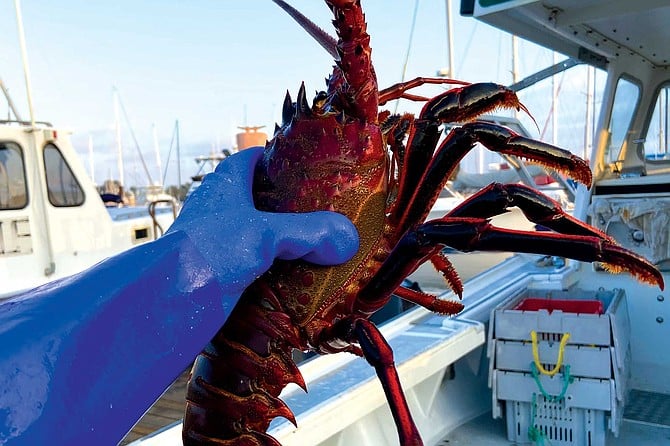
"It started with rumors, said Pete Halmay, seasoned urchin diver and president of San Diego Fishermen’s Working Group. At seventy-something, he’s still out getting salty almost every day. Two or three months before spiny lobster season was set to open in early October, Halmay said, talk on the docks was that Asia wasn’t buying this year, demand was way down due to covid-19, and the price San Diego fishermen would get for spiny lobster would be 30-50 percent of the norm. In a typical year, 95 percent of spiny lobster caught in San Diego goes to overseas markets, primarily Asia.
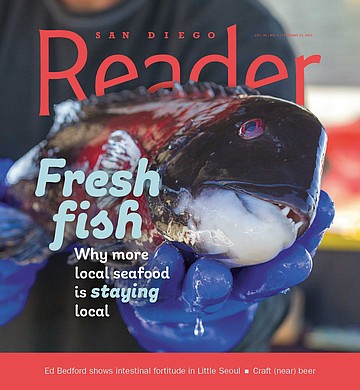
Coveted for its resemblance to a dragon, California spiny lobster is a lucky dish for Lunar New Year and is served at weddings and large get-togethers. Covid-19 crashed those parties in late 2019 and throughout 2020. Spiny lobster prices crashed too. President Trump’s trade war with China and the retaliatory tariffs didn’t help. The rumored price prior to the season opening was $8 per pound, down from the 2019 average of about $20 and 2015’s high near $30. California Department of Fish and Wildlife data showed that spiny lobster was the most profitable local catch at $3.8 million in 2017. In 2018, it brought in $3 million, beating out bigeye tuna. When the pandemic started in China in late 2019, it coincided with the height of legal spiny lobster season in California. Sales in 2019 dropped to $1.8 million. Among San Diego’s top-grossing seafoods, spiny lobster saw the biggest decline. Said Halmay, “They [local fishermen] got together and decided, ‘We can’t make a living off that. Let’s do something about it.’”
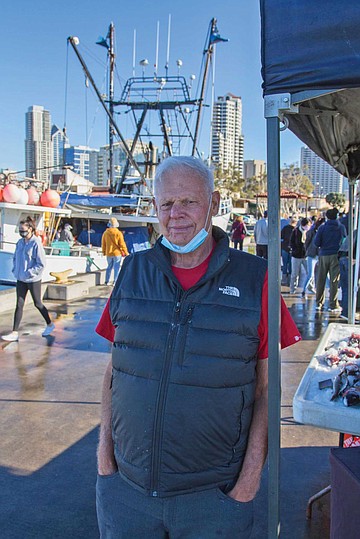
Seafood typically changes hands four or five times before reaching the consumer. In San Diego, fishermen sell off the dock to whomever is buying at the highest price, and they have no control over the “chain of custody” after that. “We know one up and one down, where it comes from and who buys it. We don’t really know for sure where it goes after that.”
“Two or three Asian buyers come down from LA,” Halmay said, “so we — ugly Americans — assume it’s going to China.”
Local wholesaler Catalina Offshore Products buys spiny lobsters in San Diego and resells to markets, including the international. Pound by pound, week by week through the end of the annual spiny lobster season in March, our local crustaceans get trucked to Los Angeles and shipped overseas. The Department of Fish and Wildlife reported that 140,630 pounds of spiny lobster landed at ports in San Diego in 2019. Meanwhile, chefs and seafood sellers bring in North American lobsters (known as Maine lobsters) from the East Coast to meet diner demand. They’re the ones with the big claws. In “normal” years, lobster from Maine is cheaper than California spiny lobster since demand from Asian markets usually drives up the price.
So San Diego fishermen decided to do something different with this year’s haul: sell directly to local consumers. Halmay has been fishing in San Diego for more than 30 years and he hasn’t seen fishermen be able to make a living this way. In typical years, they still make most of their income selling to wholesalers and restaurants. But when the pandemic started and those revenue streams started to dry up, Halmay said, “We had two choices: shut down or sell direct.”
Though local fishermen have been selling all kinds of fish direct to San Diego consumers at Tuna Harbor Dockside Market every Saturday for six years, the market was just a tiny portion of their business. While we San Diegans are encouraged to “eat local,” 2020 was the first year, Halmay said, that fishermen have made a concerted push to sell direct to local consumers as a major part of their business. In a 2016 study, California Sea Grant coastal specialist Theresa Sinicrope Talley found that less than 10 percent of the seafood consumed in San Diego is local. Only eight percent of seafood markets in San Diego consistently carry seafood caught off our coast.
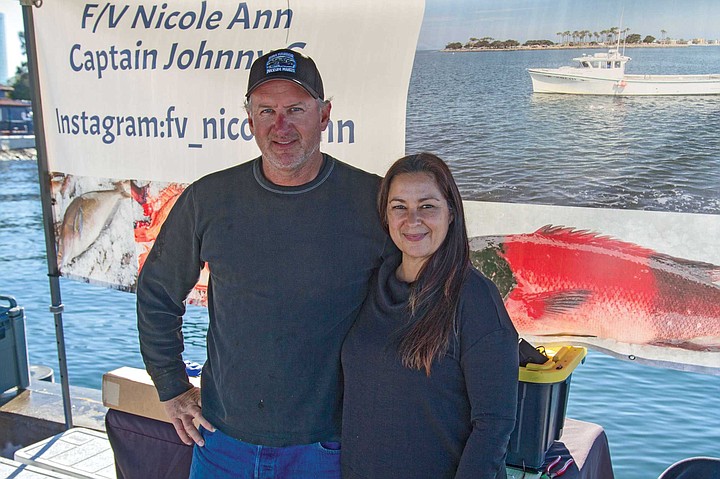
During the pandemic, selling local seafood to locals became much more lucrative, though some of the fishermen have had to reduce prices to appeal to individual customers instead of wholesale distributors with bigger budgets. Saturdays at the Dockside Market in 2020 saw long, socially distanced lines of seafood eaters eager to take advantage of more affordable prices while supporting San Diego small businesses. Social media has helped fishermen connect directly to their customers. Final numbers are not in yet for 2020, so it’s not clear exactly how profitable this new push has been. But it has been bringing in money during a time when many businesses have had to shut down completely.
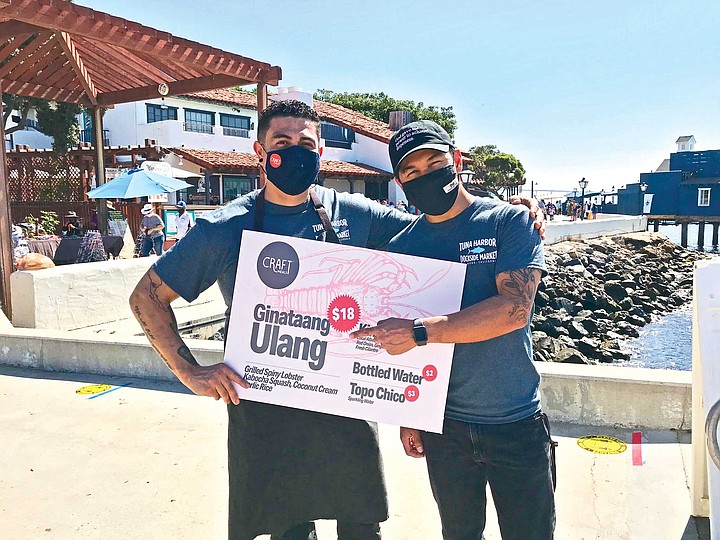
“Local demand is way up,” said Johnny Glawson, aka Captain G, who has fished off La Jolla, Point Loma, and Oceanside for 25 years. He and his wife have been selling at the dockside market for five years, bringing in sheepshead, whitefish, and rockfish, among other species. In mid-2020, Halmay said, long-liners started selling the majority of their tuna off the boat for $10 a pound to customers who were going to take it right home and eat it.
“Usually our wholesale buyers only tell us what’s wrong with our fish,” Halmay said. “Now people are saying this is the nicest fish they’ve ever seen.” Going home with happy customers in two-pound portions, 15-20,000 pounds of fresh local tuna stayed in San Diego this year. “Zero fish miles.”
Captain G and his wife Nicole Ann, namesake of their fishing vessel, opened the 2020 season with 200 pounds to sell at the inaugural California Spiny LobsterFest on October 11. Just under 100 pounds of it was coveted three-pounders, the other half was average legal size of 1.2-1.4 pounds. The Glawsons’ supply sold out in two hours, along with all eight other outfits hawking fresh catch on Tuna Pier. At off-the-boat prices of $17 per pound, 1500 pounds of spiny lobster went home to San Diego kitchens that day. During all of 2019, only 250 pounds went to local consumers from the dockside market, said Halmay, who can spout fish statistics like a computer.
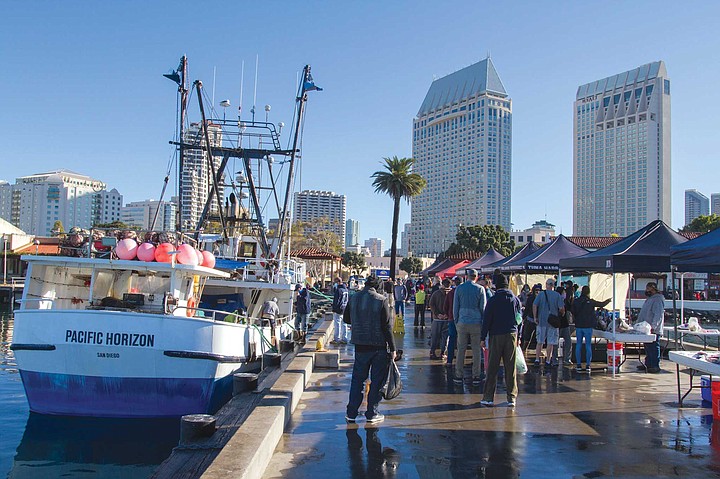
“About a quarter of our customers today were newbies,” Nicole Ann told me as she swished water around in two empty 100-quart coolers at their dockside Spiny LobsterFest booth. “They had never cooked a lobster before. They wanted to know, ‘What do I do with this animal when I get home?’”
Despite what chefs might lead customers to believe, Halmay laughed, cooking a California spiny lobster is pretty simple: boil, split, butter, paprika, broil, eat. That’s how Nicole Ann and Captain Johnny G do it. Or try Puerto Nuevo style — split down the middle, then fry in hot oil or lard for three minutes. Squeeze a lemon on it, add some salsa on the side.
“You don’t need a fancy chef to do it for you. Just do it like Grandma did it,” Halmay said. “In a hot pot or on a hot stove. Or like the guys on the boat: three minutes in the microwave.”
Chef Marcus Twilegar of Craft Meals, cooking right there on the pier while the fishermen unloaded their catch into his al fresco kitchen, had his own plan: Filipino ginataang. With kabocha squash, coconut, chili, and brown butter. Nothing fancy, just split the lobster, grill, salt and pepper, combine on plate, devour. He was telling me this after all the plates he had prepared for sale were already long gone. My stomach grumbled though it was well before lunchtime.
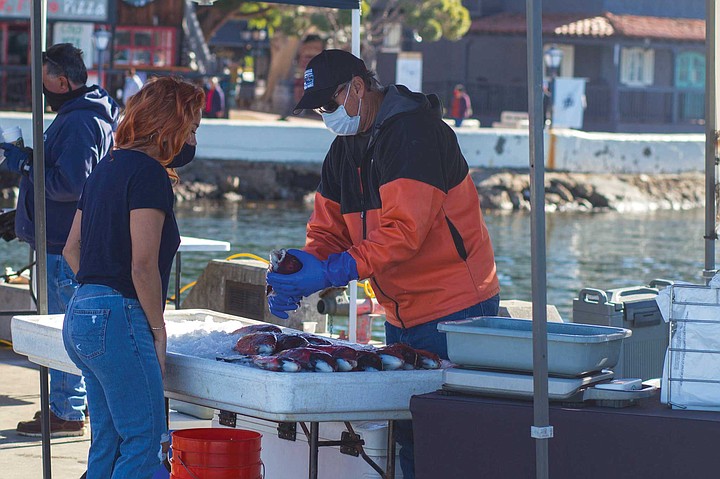
“I know, it was kind of weird, everyone eating lobster at, like, 9 am,” he laughed. Twilegar had placed an additional order for 200 pounds of fresh spiny lobster that day — a claim he forfeited to the clamoring crowd of almost 900 people who had started lining up for Spiny LobsterFest at 7:30 am. Captain Johnny G had to make a spontaneous foray on the R/V Nicole Ann to fill the chef’s order. Twilegar and his kitchen crew needed the fresh haul to prepare 300 meals for Fish to Families, a pilot program connecting San Diego’s seafood supply with local organizations distributing food to those in need due to covid-19. It’s keeping restaurant staff — such as Twilegar’s — employed.
While Twilegar waited on the pier for his share of the lobster, a woman walked up and asked where she could purchase some. She had come all the way from Rancho Peñasquitos with a cooler full of ice, to buy some “bugs,” as the crustaceans are called. She had to leave empty-handed. Like me, she had arrived too late to partake in the frenzy.
Don’t worry: there’s still plenty of spiny lobster in San Diego waters. Although Glawson and Halmay noted that this year’s catch started out relatively small, there’s “no claws for concern,” said Talley with a wink.
“Fisheries in the U.S. and California in particular are some of the best managed in the world as far as protection of fish populations and stocks, and the environment. So, you are pretty much assured that if it’s domestic seafood, it’s sustainably managed.”
In San Diego, spiny lobster has its own fan following: the SD Spiny Lobsters Facebook group, with over 1000 members. Started in September 2020 to support family-owned fishing businesses facing loss of livelihood due to the drop in spiny lobster prices and changes in the food system, the group connects fishermen, restaurants, retail markets, and seafood enthusiasts. And administrators are pushing to get elected officials to declare Spiny Lobster Day on the California calendar.
San Diego fishermen say they want to keep selling their wares directly to hungry locals at off-the-boat prices. “I think, I hope, this will keep up past the pandemic. People are figuring out lobster is easy to prepare,” Halmay said. “And it’s local, it’s a meal you can eat and feel good about.”
Halmay worked with Toni Atkins to pass the Pacific to Plate bill in 2015 to facilitate off-the-boat fish sales to consumers. Get your share at Tuna Harbor Dockside Market on Saturdays, now with online ordering, curbside pickup, and hours extended until 3 pm. Tommy Gomes, famous former fishmonger for Catalina Offshore Products, sells spiny lobsters off his boat at Driscolls Wharf in Point Loma. Legal bug season lasts until March 17.


"It started with rumors, said Pete Halmay, seasoned urchin diver and president of San Diego Fishermen’s Working Group. At seventy-something, he’s still out getting salty almost every day. Two or three months before spiny lobster season was set to open in early October, Halmay said, talk on the docks was that Asia wasn’t buying this year, demand was way down due to covid-19, and the price San Diego fishermen would get for spiny lobster would be 30-50 percent of the norm. In a typical year, 95 percent of spiny lobster caught in San Diego goes to overseas markets, primarily Asia.

Coveted for its resemblance to a dragon, California spiny lobster is a lucky dish for Lunar New Year and is served at weddings and large get-togethers. Covid-19 crashed those parties in late 2019 and throughout 2020. Spiny lobster prices crashed too. President Trump’s trade war with China and the retaliatory tariffs didn’t help. The rumored price prior to the season opening was $8 per pound, down from the 2019 average of about $20 and 2015’s high near $30. California Department of Fish and Wildlife data showed that spiny lobster was the most profitable local catch at $3.8 million in 2017. In 2018, it brought in $3 million, beating out bigeye tuna. When the pandemic started in China in late 2019, it coincided with the height of legal spiny lobster season in California. Sales in 2019 dropped to $1.8 million. Among San Diego’s top-grossing seafoods, spiny lobster saw the biggest decline. Said Halmay, “They [local fishermen] got together and decided, ‘We can’t make a living off that. Let’s do something about it.’”

Seafood typically changes hands four or five times before reaching the consumer. In San Diego, fishermen sell off the dock to whomever is buying at the highest price, and they have no control over the “chain of custody” after that. “We know one up and one down, where it comes from and who buys it. We don’t really know for sure where it goes after that.”
“Two or three Asian buyers come down from LA,” Halmay said, “so we — ugly Americans — assume it’s going to China.”
Local wholesaler Catalina Offshore Products buys spiny lobsters in San Diego and resells to markets, including the international. Pound by pound, week by week through the end of the annual spiny lobster season in March, our local crustaceans get trucked to Los Angeles and shipped overseas. The Department of Fish and Wildlife reported that 140,630 pounds of spiny lobster landed at ports in San Diego in 2019. Meanwhile, chefs and seafood sellers bring in North American lobsters (known as Maine lobsters) from the East Coast to meet diner demand. They’re the ones with the big claws. In “normal” years, lobster from Maine is cheaper than California spiny lobster since demand from Asian markets usually drives up the price.
So San Diego fishermen decided to do something different with this year’s haul: sell directly to local consumers. Halmay has been fishing in San Diego for more than 30 years and he hasn’t seen fishermen be able to make a living this way. In typical years, they still make most of their income selling to wholesalers and restaurants. But when the pandemic started and those revenue streams started to dry up, Halmay said, “We had two choices: shut down or sell direct.”
Though local fishermen have been selling all kinds of fish direct to San Diego consumers at Tuna Harbor Dockside Market every Saturday for six years, the market was just a tiny portion of their business. While we San Diegans are encouraged to “eat local,” 2020 was the first year, Halmay said, that fishermen have made a concerted push to sell direct to local consumers as a major part of their business. In a 2016 study, California Sea Grant coastal specialist Theresa Sinicrope Talley found that less than 10 percent of the seafood consumed in San Diego is local. Only eight percent of seafood markets in San Diego consistently carry seafood caught off our coast.

During the pandemic, selling local seafood to locals became much more lucrative, though some of the fishermen have had to reduce prices to appeal to individual customers instead of wholesale distributors with bigger budgets. Saturdays at the Dockside Market in 2020 saw long, socially distanced lines of seafood eaters eager to take advantage of more affordable prices while supporting San Diego small businesses. Social media has helped fishermen connect directly to their customers. Final numbers are not in yet for 2020, so it’s not clear exactly how profitable this new push has been. But it has been bringing in money during a time when many businesses have had to shut down completely.

“Local demand is way up,” said Johnny Glawson, aka Captain G, who has fished off La Jolla, Point Loma, and Oceanside for 25 years. He and his wife have been selling at the dockside market for five years, bringing in sheepshead, whitefish, and rockfish, among other species. In mid-2020, Halmay said, long-liners started selling the majority of their tuna off the boat for $10 a pound to customers who were going to take it right home and eat it.
“Usually our wholesale buyers only tell us what’s wrong with our fish,” Halmay said. “Now people are saying this is the nicest fish they’ve ever seen.” Going home with happy customers in two-pound portions, 15-20,000 pounds of fresh local tuna stayed in San Diego this year. “Zero fish miles.”
Captain G and his wife Nicole Ann, namesake of their fishing vessel, opened the 2020 season with 200 pounds to sell at the inaugural California Spiny LobsterFest on October 11. Just under 100 pounds of it was coveted three-pounders, the other half was average legal size of 1.2-1.4 pounds. The Glawsons’ supply sold out in two hours, along with all eight other outfits hawking fresh catch on Tuna Pier. At off-the-boat prices of $17 per pound, 1500 pounds of spiny lobster went home to San Diego kitchens that day. During all of 2019, only 250 pounds went to local consumers from the dockside market, said Halmay, who can spout fish statistics like a computer.

“About a quarter of our customers today were newbies,” Nicole Ann told me as she swished water around in two empty 100-quart coolers at their dockside Spiny LobsterFest booth. “They had never cooked a lobster before. They wanted to know, ‘What do I do with this animal when I get home?’”
Despite what chefs might lead customers to believe, Halmay laughed, cooking a California spiny lobster is pretty simple: boil, split, butter, paprika, broil, eat. That’s how Nicole Ann and Captain Johnny G do it. Or try Puerto Nuevo style — split down the middle, then fry in hot oil or lard for three minutes. Squeeze a lemon on it, add some salsa on the side.
“You don’t need a fancy chef to do it for you. Just do it like Grandma did it,” Halmay said. “In a hot pot or on a hot stove. Or like the guys on the boat: three minutes in the microwave.”
Chef Marcus Twilegar of Craft Meals, cooking right there on the pier while the fishermen unloaded their catch into his al fresco kitchen, had his own plan: Filipino ginataang. With kabocha squash, coconut, chili, and brown butter. Nothing fancy, just split the lobster, grill, salt and pepper, combine on plate, devour. He was telling me this after all the plates he had prepared for sale were already long gone. My stomach grumbled though it was well before lunchtime.

“I know, it was kind of weird, everyone eating lobster at, like, 9 am,” he laughed. Twilegar had placed an additional order for 200 pounds of fresh spiny lobster that day — a claim he forfeited to the clamoring crowd of almost 900 people who had started lining up for Spiny LobsterFest at 7:30 am. Captain Johnny G had to make a spontaneous foray on the R/V Nicole Ann to fill the chef’s order. Twilegar and his kitchen crew needed the fresh haul to prepare 300 meals for Fish to Families, a pilot program connecting San Diego’s seafood supply with local organizations distributing food to those in need due to covid-19. It’s keeping restaurant staff — such as Twilegar’s — employed.
While Twilegar waited on the pier for his share of the lobster, a woman walked up and asked where she could purchase some. She had come all the way from Rancho Peñasquitos with a cooler full of ice, to buy some “bugs,” as the crustaceans are called. She had to leave empty-handed. Like me, she had arrived too late to partake in the frenzy.
Don’t worry: there’s still plenty of spiny lobster in San Diego waters. Although Glawson and Halmay noted that this year’s catch started out relatively small, there’s “no claws for concern,” said Talley with a wink.
“Fisheries in the U.S. and California in particular are some of the best managed in the world as far as protection of fish populations and stocks, and the environment. So, you are pretty much assured that if it’s domestic seafood, it’s sustainably managed.”
In San Diego, spiny lobster has its own fan following: the SD Spiny Lobsters Facebook group, with over 1000 members. Started in September 2020 to support family-owned fishing businesses facing loss of livelihood due to the drop in spiny lobster prices and changes in the food system, the group connects fishermen, restaurants, retail markets, and seafood enthusiasts. And administrators are pushing to get elected officials to declare Spiny Lobster Day on the California calendar.
San Diego fishermen say they want to keep selling their wares directly to hungry locals at off-the-boat prices. “I think, I hope, this will keep up past the pandemic. People are figuring out lobster is easy to prepare,” Halmay said. “And it’s local, it’s a meal you can eat and feel good about.”
Halmay worked with Toni Atkins to pass the Pacific to Plate bill in 2015 to facilitate off-the-boat fish sales to consumers. Get your share at Tuna Harbor Dockside Market on Saturdays, now with online ordering, curbside pickup, and hours extended until 3 pm. Tommy Gomes, famous former fishmonger for Catalina Offshore Products, sells spiny lobsters off his boat at Driscolls Wharf in Point Loma. Legal bug season lasts until March 17.
Comments